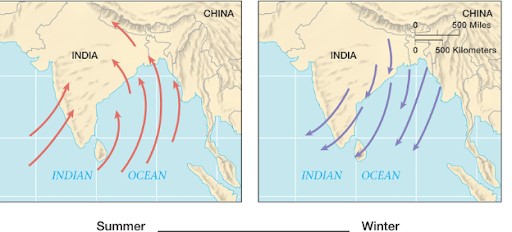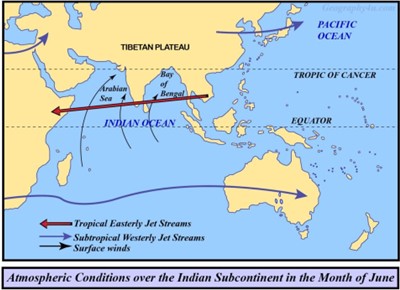-
01 Feb 2024
GS Paper 1
Geography
Day 64: Discuss the characteristics and mechanisms underlying the initiation of the monsoon season in India. How do El Niño and La Niña events impact the Indian monsoon? (250 words)
- Start the answer with a discussion that sets a context for the question.
- Discuss the characteristics and mechanisms of the Indian Monsoon.
- Explain the impact of El Niño and La Niña on the Indian Monsoon.
- Conclude suitably.
Introduction
The monsoon season in India is a crucial climatic phenomenon, determining the country's agricultural output, water resources, and overall socio-economic conditions. The monsoon season typically begins in June and lasts until September.
Body
The initiation and behavior of the monsoon are influenced by various characteristics and mechanisms which include:
- Seasonal Reversal of Winds: The Indian monsoon is characterized by the seasonal reversal of winds.
- Southwest Monsoon: During summer, hot air masses over the Indian subcontinent create a low-pressure area that draws in moist air from the Indian Ocean, resulting in the southwest monsoon which typically begins in June and lasts until September.
- It brings heavy rainfall to various parts of the country, especially the western coast and northeastern regions.
- Northeast Monsoon: In the winter months, from October to December, the landmass cools down, creating a high-pressure area over the Indian subcontinent, leading to the northeast flow of winds. These winds are known as the northeast monsoon or retreating monsoon.
- The retreating monsoon winds bring rainfall to the southeastern parts of the country, including Tamil Nadu and parts of Andhra Pradesh.
- Southwest Monsoon: During summer, hot air masses over the Indian subcontinent create a low-pressure area that draws in moist air from the Indian Ocean, resulting in the southwest monsoon which typically begins in June and lasts until September.
- Movement of ITCZ: The northward movement of the Intertropical Convergence Zone (ITCZ) is closely linked to the onset of the Indian monsoon. As the ITCZ shifts northward, it brings with it the moist southwest winds, initiating the arrival of the monsoon over the Indian subcontinent.
- The onset of the monsoon is marked by the arrival of rains over the southwestern coast of India, usually around June. This is followed by a gradual progression across the country, covering different regions in subsequent weeks.
- Flow of Tropical Easterly Jet Stream: The tropical jet stream flows from east-to-west (10-12 km above the Gangetic plains) across India, and subsides above the Indian Ocean, where it then lends extra energy to and ‘pushes’ the southwest monsoon towards India.
- Creation of Monsoon Trough: The monsoon trough, an extension of the low-pressure area, plays a crucial role in determining the distribution of rainfall. It influences the movement of the monsoon across different regions.
- Role of Mountains:
- The Himalayan mountain range acts as a barrier, influencing rainfall patterns. The windward side receives more rainfall, creating a rain shadow effect on the leeward side.
- The Western Ghats also play a role in enhancing rainfall along the western coast.
El Niño and La Niña Impact on Indian Monsoon:
- El Niño:
- El Niño is characterized by the warming of sea surface temperatures in the central and eastern Pacific Oceans. This warming influences atmospheric circulation patterns globally.
- In India, El Niño is associated with a weakened monsoon, leading to drier-than-normal conditions. It disrupts the usual rainfall patterns, affecting agriculture and water resources.
- La Niña:
- La Niña, conversely, involves cooler-than-average sea surface temperatures in the central and eastern Pacific Ocean. It influences atmospheric circulation in a way that can enhance the Indian monsoon.
- La Niña events are associated with above-average rainfall in many parts of India. This can lead to increased flooding in some regions.
Conclusion
Understanding the characteristics and mechanisms governing the Indian monsoon is essential for anticipating and managing the socio-economic impacts of this seasonal phenomenon. The influence of El Niño and La Niña events adds a layer of complexity, requiring careful monitoring and adaptation strategies to mitigate the potential consequences on agriculture, water resources, and overall livelihoods.






